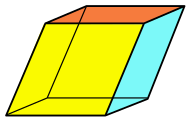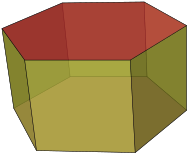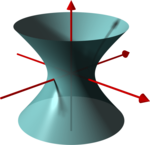

This article needs additional citations for verification. Please help improve this articlebyadding citations to reliable sources. Unsourced material may be challenged and removed.
Find sources: "Solid geometry" – news · newspapers · books · scholar · JSTOR (May 2014) (Learn how and when to remove this message) |

Solid geometryorstereometry is the geometryofthree-dimensional Euclidean space (3D space).[1]
Asolid figure is the region of 3D space bounded by a two-dimensional surface; for example, a solid ball consists of a sphere and its interior.
Solid geometry deals with the measurementsofvolumes of various solids, including pyramids, prisms (and other polyhedrons), cubes, cylinders, cones (and truncated cones).[2]
The Pythagoreans dealt with the regular solids, but the pyramid, prism, cone and cylinder were not studied until the Platonists. Eudoxus established their measurement, proving the pyramid and cone to have one-third the volume of a prism and cylinder on the same base and of the same height. He was probably also the discoverer of a proof that the volume enclosed by a sphere is proportional to the cube of its radius.[3]
Basic topics in solid geometry and stereometry include:
Advanced topics include:
Whereas a sphere is the surface of a ball, for other solid figures it is sometimes ambiguous whether the term refers to the surface of the figure or the volume enclosed therein, notably for a cylinder.
| Figure | Definitions | Images |
|---|---|---|
| Parallelepiped |
|

|
| Rhombohedron |
|

|
| Cuboid |
|

|
| Polyhedron | Flat polygonal faces, straight edges and sharp corners or vertices | |
| Uniform polyhedron | Regular polygonsasfaces and is vertex-transitive (i.e., there is an isometry mapping any vertex onto any other) |
|
| Prism | Apolyhedron comprising an n-sided polygonal base, a second base which is a translated copy (rigidly moved without rotation) of the first, and n other faces (necessarily all parallelograms) joining corresponding sides of the two bases | 
|
| Cone | Tapers smoothly from a flat base (frequently, though not necessarily, circular) to a point called the apexorvertex |  |
| Cylinder | Straight parallel sides and a circular or oval cross section |
|
| Ellipsoid | A surface that may be obtained from a sphere by deforming it by means of directional scalings, or more generally, of an affine transformation |   sphere (top, a=b=c=4), spheroid (bottom left, a=b=5, c=3), tri-axial ellipsoid (bottom right, a=4.5, b=6, c=3) |
| Lemon | Alens (or less than half of a circular arc) rotated about an axis passing through the endpoints of the lens (or arc)[6] | 
|
| Hyperboloid | Asurface that is generated by rotating a hyperbola around one of its principal axes | 
|
Various techniques and tools are used in solid geometry. Among them, analytic geometry and vector techniques have a major impact by allowing the systematic use of linear equations and matrix algebra, which are important for higher dimensions.
A major application of solid geometry and stereometry is in 3D computer graphics.